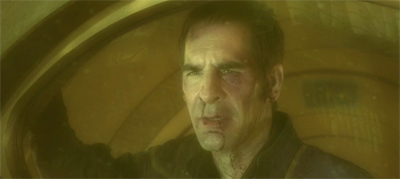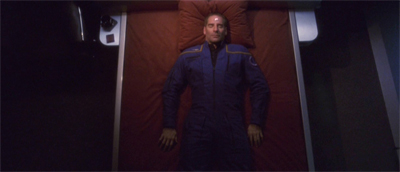Next year, Star Trek is fifty years old. We have some special stuff planned for that, but – in the meantime – we’re reviewing all of Star Trek: Enterprise this year as something of a prequel to that anniversary. This August, we’re doing the third season. Check back daily for the latest review.
The stock comparison for Damage is In the Pale Moonlight.
This makes a great deal of sense. After all, both are Star Trek episodes that hinge on a series of morally questionable decisions made by the lead actor in a moment of sheer desperation. In In the Pale Moonlight, Benjamin Sisko starts a chain of events that builds towards the assassination of a Romulan Senator to trick the Romulans into joining the war effort. In Damage, Jonathan Archer resorts to piracy in order to obtain the parts necessary to make a meeting with Degra in order to plead against the use of the Xindi weapon.
There are some notable differences, of course. In purely practical plotting terms, Sisko dominates the narrative of In the Pale Moonlight; the entire story is related directly by Sisko to the audience in the form of a personal log. In contrast, Damage is split between the demands of Archer’s own arc in the episode and various other continuity elements; the episode needs to get Archer back to his ship and devote a considerable amount of time to T’Pol’s addiction. As a result, it lacks the keen focus that made In the Pale Moonlight so compelling.
At the same time, there is something much more direct about Damage. Sisko is quite detached from the horrors of In the Pale Moonlight, with the audience insulated from his choices through the use of a framing device and Sisko himself insulated through his use of Garak to conduct all the unpalatable actions. In contrast, Archer makes a point to bloody his own hands over the course of Damage. He doesn’t have somebody else to make the decision for him; he leads the boarding party himself.
It is a very bold an unsettling choice, a culmination of a character arc that has been pushing Archer towards this sort of horrific choice since Anomaly. The third season of Star Trek: Enterprise has not been entirely consistent when it comes to its character arcs, working better in broad strokes than in fine detail. Nevertheless, Damage represents a very clear commitment to the promise of the third season of Enterprise; an interrogation of the franchise’s core values in an increasingly morally ambiguous world.
Damage is a deeply uncomfortable and unsettling episode of Star Trek, but it is arguably a necessary one. It is, in many ways, a criticism of the moral absolutism that informs a lot of discussion about terrible situations, suggesting that reality is often a lot more complicated than people might hope it would be.
Filed under: Enterprise | Tagged: ambiguity, Archer, Brannon Braga, consequences, continuity, damage, david a. goodman, enterprise, episodic, in the pale moonlight, jolene blalock, moral ambiguity, morality, piracy, Sisko, star trek: enterprise, t'pol, war on terror | 9 Comments »
























